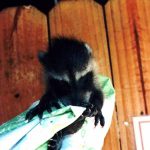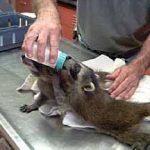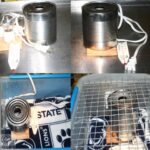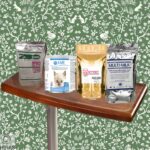Caring For Orphaned And Injured Raccoons – Raising Baby Bandits
Ron Hines DVM PhD
 All Of Dr. Hines’ Other Wildlife Rehab Articles
All Of Dr. Hines’ Other Wildlife Rehab Articles
![]() Orphaned wildlife tend to knock more than once on the door of a kind-hearted person. So, for baby birds go here, opossums here, cottontail rabbits here, squirrels here and here, turtles here. Bobcats and other such creatures are best left for professionals only, but go here.
Orphaned wildlife tend to knock more than once on the door of a kind-hearted person. So, for baby birds go here, opossums here, cottontail rabbits here, squirrels here and here, turtles here. Bobcats and other such creatures are best left for professionals only, but go here.
 Baylisascaris , is a parasite you need to know about and respect Read about baylisascaris here
Baylisascaris , is a parasite you need to know about and respect Read about baylisascaris here
Raccoons in captivity need vaccinations to protect them from dog distemper, parvo (and perhaps cat distemper/panleukopenia). Read about that here
But WAIT! Be Sure To Read All The Good Reasons For Not Raising And Releasing Raccoons That I Give At The End Of This Article
Well, How Old Do You Think This Baby Raccoon Is Anyway?
Ages in order clockwise: 4 weeks, 5 weeks, 6 weeks, 7 weeks, 8 weeks, 28 wks.
You can also “guesstimate” that:
![]() A 100-gram or less baby raccoon is a week or less old (has a very light hair fuzz) (4 ½ -6” nose-end of tail) (Eyes closed, ears unopened)(Crawls spraddle-legged)
A 100-gram or less baby raccoon is a week or less old (has a very light hair fuzz) (4 ½ -6” nose-end of tail) (Eyes closed, ears unopened)(Crawls spraddle-legged)
![]() A 250 gram baby is about 2 ½ weeks old (about 8 ½ long)
A 250 gram baby is about 2 ½ weeks old (about 8 ½ long)
![]() A 350 gram baby is about 3 ½ weeks old (about 10″ long) (eyes open 2 ½-3 wks)
A 350 gram baby is about 3 ½ weeks old (about 10″ long) (eyes open 2 ½-3 wks)
![]() A 550 gram baby is about 5 ½ weeks old (about 12-14″ long) (ears open about 4 wks) (begin to walk)
A 550 gram baby is about 5 ½ weeks old (about 12-14″ long) (ears open about 4 wks) (begin to walk)
![]() A 950 gram baby is about 9 ½ weeks old (eating solid foods, very active and independent)
A 950 gram baby is about 9 ½ weeks old (eating solid foods, very active and independent)
![]() A 1500- 2000 gram baby ( time you need to have started giving it the skills it will need for release*)
A 1500- 2000 gram baby ( time you need to have started giving it the skills it will need for release*)
*Because I deal with urban raccoons, I might consider giving them Emrab®-3 killed rabies vaccine and a ferret-approved distemper vaccination – both produced by Merial/Boehringer Ingelheim – as well as a “killed” (inactivated) cat parvovirus (aka cat distemper/panleukopena ) vaccination. This is highly frowned upon by all Government officials and many veterinarians for various plausible reasons and may even be illegal in your locality. I also worm all of them with pyrantel pamoate three time at weekly intervals. There are other safe and effective ways to rid raccoons of intestinal worms including baylisascaris. ( ask me for Bauer1994) When fleas are seen, I dust them with a 50-50 mixture of Sevin™ (carbaryl) garden dust and corn starch. I also pick off any ticks I might find with tweezers and drop them into a cup of alcohol – then flush them. Treat new arrivals and throw away whatever box and bedding the raccoons arrived in before you bring them into your facility.
What Else To Do When A Baby Raccoon Arrives
Dehydration is very common in orphaned raccoon kits when they are first found. A baby raccoon that is 5% dehydrated (which is not uncommon) needs to receive about 4-5% of its body weight of balanced fluids over an 8-hour period. In many cases that can be given orally (Pedialyte™ and similar products). But because of time constraints I give fluids by injection subcutaneously (just under the skin). With great care and sterility, fluids can be given through the skin of the tummy (intraperitoneally). I avoid that whenever possible. It is only when I believe that a baby raccoon is on “death’s doorstep” with a circulatory system too collapsed to absorb fluids placed under its skin that intraperitoneal injections are warranted. You can read about the many types of injectable fluids available here.
The physical signs of dehydration can be easily overlooked: Skin that is slightly doughy and wrinkly without its normal spring back ability. A dry mouth. Weakness and listlessness. A baby raccoon that is about 8% dehydrated will definitely have skin doughy to the touch (skin that doesn’t spring back when plucked like a guitar string). The kit’s eyes will be sunken. Its body will most likely be cool to the touch unless it was stranded in the sun. When dehydration in immature raccoons reaches 10% the kit will most likely be in a stupor (semi-coma). Baby raccoons are rarely alive when they are more than 13% dehydrated. But should one be, it needs a veterinarian, vet tech or human phlebotomist involved to place a catheter in a vein. That is not at all an easy task. Another option is an oral tube placed down its esophagus into its stomach – however severely dehydrated raccoon kits with a collapsed circulatory system do not absorb fluids from their stomach or intestines well and a distended stomach quickly blocks their vital respiration.
Babies that are cold to the touch need immediate warming. Part of that (hypothermia) is due to them having less hair. But more responsible is that when an animal is small, its surface area is greater per gram of body weight than it will be later in life. That results in babies of all kind loosing heat faster than adults. After giving dehydrated babies warmed subcutaneous fluids, I like to place them on a hot water bottle or one of the 3-M Hot/Cold Packs that hospitals use. Heat lamps and heating pads can be dangerous. Take it from me, it is so easy to accidentally overheat baby animals when you are busy attempting to do multiple things at once. Many arrive so weak that they cannot move on their own to a temperature that is within their comfort zone. Once a raccoon kit weights about 300 grams and is already a chirper, it should be able to find its own comfort zone when a heat gradient source is provided near by it.
I make a surrogate warming “Mom” from a 20 ounce tin can placed over a 15 or 20 watt light bulb. The Home Depot sells what you will need to make one. If you wrap the can in a soft material – be sure it is non-flammable and does not give off toxic fumes. I personally don’t wrap the can in anything (the hole in the top is because it doubles as an egg candler) . I try to slowly bring their body temperatures up to 100 F/37.8 C before I attempt to give them anything orally. For me, the subcutaneous fluids tide them over. A normal unstressed, adult raccoon has a body temperature of about 102.8 F/39.3 C.
How Do I Encourage A Baby Raccoon To Urinate And Defecate?
Most furry creatures are induced to do that by their mother’s licking of their genital area. A warm moistened pledget of cotton massaged on that area should accomplish the same thing. Once youngsters are eating from a dish, that should no longer be necessary.
What Should I Feed This Baby?
You have three milk replacement choices: Zoologic’s Milk Matrix 42/25™ produced by PetAg for nursing wildlife. The traditional KMR™ product also produced by PetAg and sold in most every pet supply outlet. Fox Valley’s Day One 40/25™ sold through online wildlife rehabilitation supply sites and directly by the Company. There are as many custom raccoon, squirrel and cottontail milk formula recipes as Grandma’s fruitcake recipes. Some once included as a component the Multi-Milk™ seen in the image above. Multi-Milk™ was a very high fat low lactose product once sold by PetAg. It no longer appears on the PetAg website.
A lot of chatter concerns which of these three might be best. But no one has every done what would be needed to make an informed choice. That would require a single or groups of wildlife rehabilitators to splitting up a number of orphan raccoon litters of the same age into three groups and having the same person feed each of the three groups with a different one of these products – (what scientists call a blinded study ).
When wildlife babies didn’t thrive as well as you wish they had, it is common to suspect the manufacturer of the diet might to blame. It is only natural that those suspicions tend to resonate and magnify withing the wildlife rehab community. However how how much you feed per feeding how you reconstitute these products and your general techniques in animal care are equally as important. Those are things that you learn from experience and the experience of others you rely on. Some of these babies will arrive at your door star crossed. Perhaps they overheated to the point of organ damage. Perhaps they dehydrated from thirst or in the hot sun beyond recovery. Perhaps they arrived in the early stages of one of the many infectious diseases of raccoons. (read here and here ) Perhaps the diarrhea the baby(s) experienced was due to salmonella or some other food poisoning. Perhaps raccoon herpesvirus. Perhaps due to overheated before reaching you the kit(s) already had toxic levels of heat shock proteins in their system. When that occurs, failure to thrive can be temporary or permanent. Read about heat shock protein formed by overheating here and here Over-feeding any of these three formulas can also result in bloat, milk in the lungs and aspiration pneumonia with fatal consequences – or simply a baby raccoon that does not thrive despite all your efforts.
Remarkably despite all the controversy over nursing raccoon formulas, no one has ever done a respectable analysis of raccoon milk over the length of a raccoon mother’s lactation period. The constituents of all wild animal milk is never constant. The amount of each constituents change depending on the number of kits being fed, the diet of the mother, and even the nipple being sampled. It also changes as the nursing period progresses. There was a small study in 1962 that reported that the milk of raccoons contained 4.9-6.1% protein, 3.9-4.1% fat, 4.7% carbohydrate and 16.2% total solids. (ask me for Whiteside2009) According to another source, raccoon milk contained 4% protein, 3.9% fat, 4.7% carbohydrate and 88% water. (ask me for BenShaul1962) Unlike cow’s milk, the carbohydrate portion of raccoon milk contains very little lactose – a sugar associated with bloat, colic and diarrhea in orphaned raccoons. (ask me for Urashima2018)
None of the three powders store well. One reason is that all high-fat products are subject rancidity as time goes by. In that process other nutrients are destroyed. I prefer to purchase formulas and nutritional supplements from suppliers that have the most rapid turnover.
Most folks using the KMR and Fox Valley products begin with a powder to water ration of 1:2. Other feed it a bit more dilute (up to 1:3 at first). You are always safer to begin with a more water-diluted mix fed more often and gradually increase the powder concentration as the days go by to avoid diarrhea. Dehydrated or perhaps all incoming neonatal animals need to begin with just Pedialyte® or something similar. As time goes by you can begin adding some powdered formula to the Pedialyte® and as more time passes substitute water for the Pedialyte®. There are no hard and fast rules. Much relies on the intuition that comes with your experience.
Nature designed raccoons to be omnivores that thrive in a niche where dietary ingredient change with the season. It gave them a brain intelligent enough to seize any food opportunity that presented itself and it gave them nutritional requirements that were very flexible early as well as later in their lives. When it comes to the protein, fat, carbohydrate, mineral and vitamin content of these three products, I do not believe that any of them differ enough to be significant. A raccoon kit could thrive on all of them. If there is a brand difference, it would be in the quality of the individual ingredients used to produce the powders and/or the manufacturing methods used. I believe that only Fox Valley states that human-grade products are used.
You can avoid lumpiness and foaming by using warmed water to reconstitute the powders, stir only gently and allowing the mixtures about 4 hours in your refrigerator before warming and using. If you decide to change products, make that change gradually by mixing the old and the new together.
How Should I Feed This Baby?
Tube feeding
I usually tube feed infant wildlife. That is because I get in weak baby and lots more than I could possibly bottle feed. I feed them through a flexible plastic tube attached to a syringe. I cannot explain to you in writing how this is done appropriately. You will have to watch an experienced person tube feed or perhaps watch a video on the internet of how a puppy or kitten is tube fed. But I suggest that you actually be in the room observing an experienced person tube feed before trying because you can cause serious damage (eg aspiration pneumonia) if you do it wrong.
The diameter, length and flexibility of the tube are quite important. Sometimes I rig them from clear IV extension tubing with one end cut of. Or if ordinary IV tubing is used, one end can be placed in hot water and the PVC tube can be forced over a luer slip syringe tip. 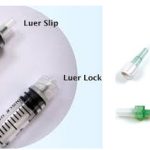 Be sure the formula is all the way to the end of the tube and that there are no air bubbles in the syringe or tube or you will inject that air into the stomach. In small babies, it is easy to see the tube pass down alongside the trachea (windpipe) and know it is not going into the lungs – but you need to see it done and have someone guide you in your first attempts before you attempt it. Again, small amounts are best. You are always safer giving the formula in the mouth, drop by drop. Milk should never exit the nose. Massage and burp them after every feeding.
Be sure the formula is all the way to the end of the tube and that there are no air bubbles in the syringe or tube or you will inject that air into the stomach. In small babies, it is easy to see the tube pass down alongside the trachea (windpipe) and know it is not going into the lungs – but you need to see it done and have someone guide you in your first attempts before you attempt it. Again, small amounts are best. You are always safer giving the formula in the mouth, drop by drop. Milk should never exit the nose. Massage and burp them after every feeding.
Bottle Feeding
Use the same size bottle as you would for a kitten or puppy of equal size. You can get more general advice on that here. Baby raccoons can drink 1-5% of their body weight in milliliters (ml=cc) at a feeding – better you stop before the animal is overfilled and refusing. The heavier the baby, the larger percent of its body weight it will drink at a feeding. Nothing is written in stone. Northern raccoons tend to be larger than southern raccoons, large litters lighter than small litters. Also, dehydrated babies weigh considerably less than they should. They need to be rehydrated with warm Lactated Ringer’s Solution 4 hours and then their body temperatures brought to 101 F/38.3 C before you attempt to give them anything orally. A normal unstressed, adult raccoon’s body temperature is about 102.8 F/39.3 C. Try to hold the baby in a semi-horizontal position – much as its natural mother would. Don’t feed them upside down.
From the first few days of life to 31 days, raccoon kits can be fed warm, reconstituted infant kitten (some use dog formula) milk replacer through a plastic 1 ml pipette whose end has been smoothed over a lighter. This way, they ingest no air and you maintain flow rate with your thumb and index finger. The first few days I mix one part KMR powder with two to three parts of warm water, some successfully use Nurturall™. Slowly, over a few days, I increase the concentration of the formula to two parts powder and three parts water. At 200 grams or so, most do well on a kitten-nursing bottle. Poking the optimal number if holes in the latex cap is an art – if you’re a novice, buy several. I have seen many more intestinal and lung problems on babies fed too much formula than too little.
The secret of success is, frequent, moderate feedings – Just plump out their tummies a bit. I have never found it necessary to feed late at night – but some folks do a midnight feeding when the babies weigh less than 60 grams (two ounces). Mix the powdered formula, as you need it. If diarrhea occurs, dilute the strength of the formula and give them a few drops of infant colic relief remedy and feed them a bit less but a bit more frequently. Sour milk occurs amazingly rapidly. If you try to freeze the reconstituted formula or canned liquid formula it will thaw clumpy. It is probably unchanged nutritionally, but I don’t like the look of it. You can also spread problems from litter to litter if you reuse, formula and do not boil the bottles. I just put them submerged in a deep Pyrex bowel in the microwave for 4-5 minutes. If the bottle warps – you cooked it too long.
From 28 – 65 days – Waring-blend some Purina Puppy Chow into the milk formula 2/3 milk 1/3 formula and make the nipple hole larger. At a bit older than two months (some as early as a-month-and-a-half, I worm the baby with pyrantel pamoate, orally at 11 mg/kg/5 mg/pound and do this every 3 days for approximately 3 weeks. Pyrantel pamoate is very low in toxicity because it is not absorbed from the intestine. It is sold under the trade names Nemex and Strongid and also for pinworms in children. At the same time, begin putting shallow, hard to tip or clip-on-the-cage bird dishes in its enclosure, filled with moistened puppy chow (I have always liked to use Purina Puppy Chow). Poke the baby’s face gently into the dish and smear some of the concoction on its palate (between it’s upper teeth) to give him the idea. You will need to use a moist terrycloth towel to clean their fur of caked-on food.
From 8-10 weeks of age, once they are eating the puppy chow well, I begin introducing the babies to tastes they will encounter in the wild and spend as little time with them as I can. Making pet’s of them is not a good idea at all if you have any intention of ever releasing them successfully. The foods you give them need to be the ones raccoons eat in your neck of the woods. Raccoons have the most adaptable opportunistic dietary habits of any North American animal I know of. Those living on my part of coastal Florida browse the beaches and salt flats for crabs, trapped or dead fish and anything else that washes in. Those in our local parks live of junk food scraps. In central Texas, mulberries, wild grape, lizards, snakes and wild raspberry, etc. form a large portion of their diet. Small rodents, immature or injured birds bird’s eggs, crayfish, earthworms, beetles, and small rodents are all appreciated when available. A live bait store is a good raccoon supermarket. Poking through the scat (fecal pellets) of wild raccoons in your area will give you an idea of what they are consuming – do it wearing gloves. Goldfish are fine, so are gambuzia minnows.
To get them to try new foods, offer the novel diets in the evening and don’t add the dog kibble until the next morning. Two or more babies seem to adapt to dietary changes faster than a single infant. I personally try to part company with the babies at this stage and let others raise them out because I am a vegetarian and squeamish about killing living things (please do not lecture me about this). Most rehabilitators just feed them the hopeless cases that come in, baby bunnies with severe wounds, birds that will never fly again, etc. but nothing overtly diseased – it’s a cruel world. Be sure they consume all of the prey, because at this age they are very susceptible to metabolic bone disease (rickets). This occurs when they just eat meat or fish flesh (high in phosphorus and low in calcium). I do not suggest you feed supermarket meats. If for some reason you do, you will need to sprinkle the meat with a pediatric or animal vitamin mix and a Calcium supplement or the raccoons will not thrive. They are particularly susceptible to vitamin B-1 (Thiamine deficiencies if dead or frozen fish is fed). Meat is also much too rich in protein and low in fiber to keep an animal healthy.
What Can I Do For An Injured Or Sick Adult Raccoon?
The safest thing to do (and quite often the only legal thing to do) is to telephone your local wildlife rehabiltator, animal control officer or game warden. Remember that in many portions of the United States, raccoons are a major transmitter of rabies. They will also bite hard if you try to handle adults or young-of-the-year animals. The majority of these sick or injured animals, when taken to a public official, will be put down (euthanized). You can call around but few veterinarians or zoos will want to get involved. First off, they would face potential legal liability and fines if they did and secondly, most know little about raccoons. There are vets with a special interest in wildlife medicine – but not very many.
I have found that surgical methods and pharmaceutical doses applicable to cats work well in raccoons. But when I suture them, I do it as I do in monkeys (subcuticular) so that no superficial sutures are present or ever need to be removed. Most adult raccoons brought to me have either been hit by cars or attacked by dogs. Those hit by cars with minor injuries or limb fractures usually limp off into the undergrowth. So I see a preponderance of head injuries that resulted in mental disturbances. Many of these animals are unaware of their surroundings. Often, if they are rehydrated, tube-fed, given some IV steroids (SoluDeltaCortef) and simple cage rest they will recover in a few days. None I have nursed that were still spacey after a week or two ever recovered sufficiently to be released. Please do not do any of this unless you have a fully staffed animal hospital and all your staff have been immunized against rabies. For the record, I am immunized against rabies.
Three-legged urban raccoons missing a rear leg or have a single functional eye seem to do OK. I euthanize front limb injuries that I cannot repair or three-legged rural raccoons. Rabies can also present with these signs or no signs. The next most common reasons adults come in is due to infection with canine distemper. I have read that Feline Distemper will also affect raccoons but I have never seen a confirmed case. Early in canine distemper, the animals are weak,run fevers and have crusty eyes. Sometimes their nose is occluded as well. It progresses quite rapidly and there is no successful treatment for it. The animals soon develop fetid (odorous) diarrhea, cease eating and drinking and often tremble. Later they develop brain and spinal cord disease that is indistinguishable from rabies. Around the country, it tends to occur in cycles when many animals are presented a few days apart. In central Texas, it was the primary reason raccoons were out in the daytime. The virus can only survive a few minutes or less when in a dry, sunny area but sneezes are very infectious to neighboring raccoons. Bleach, diluted 1 part to twenty parts of water kills the virus instantly unless there is a lot of organic material (dirt) present. I have used chicken embryo origin canine distemper vaccine successfully in raccoons. That is, it did not hurt them. I have not done experiments to see what level of immunity they developed.
What Type Of Housing And Caging Will I Need ?
When the babies are 8-10 weeks old, I place them in groups in elevated stainless steel primate cages in a shaded area with sheet metal above to keep them dry. I was lucky to find and re-weld these. I have always purchase what I needed to build good cages out of 1 x 1″ black vinyl-coated 18-gauge galvanized mesh from Memphis Net and Twine Co. Call them 800 238-6380 and have them send you their catalog. They are not the only supplier – just be sure the sources you compare are quoting the same gauge and coatings. (Some give the gauge of the steel wire before it is dipped in vinyl and some after.)
The all vinyl meshes will not keep in a raccoon. I like the sleeve-style stainless steel (hog) rings when constructing cages – the galvanized ones rust quickly and look unsightly. I do not mix raccoons with disparities in size (no big ones with little ones). I feed and hose off the cages twice a day, quickly, and stay away from them as much as I can so they become wild and wary. An occasional blast of water is a good humane way to teach them to fear man. My cages are on 4 foot steel posts anchored in cement, so other animals and visiting raccoons cannot bother them.A large stainless steel dog-watering bowl with a brick in it works well for water. I wear no gloves and get bit frequently.
How Will I Eventually Release This Raccoon?
When I lived in a wooded, rural area, I did what I do with all wildlife. When I think the animals can fend for themselves (about four to five months old) I fatten them up as much as I can. Then I leave the cage door open and continue to place food in it until the animals no longer return. Unfortunately, raccoons enjoy a free lunch and many return forever at mealtime. I once raised a barn owl that returned at dusk, every night for a year for his super. Now I (and most of you) are faced with a dilemma greater than raising the offspring – where can we release them where they will thrive? The simple fact of the matter is that any area in the United States that can support a given number of raccoons already has that number of raccoons living there. If you take them far away, you risk the possibility of spreading distemper or rabies – so don’t do that. You will have to come to terms with this dilemma on your own because I do not know the answer. I suppose the youngster might replace one killed on the road or an old one in its twilight years.
Some General Information
I have maintained non-releasable raccoons for many years on Purina Dog Chow. Zoos often add a good quality vitamin/mineral supplement but I find this unnecessary and in some cases deleterious. Puppy and kitten chows are too high in protein for long-term health. You can also feed Zupreem Brand or Mazuri™ Brand Omnivore Diet (Although I personally feel both these diets are too high in protein (26%) and fat and too low in fiber).
You can make a zoo-type diet yourself, but the animals tend to pick through it and their actual intake may be unhealthy. However, many zoos do this by combining dog chow, diced vegetables and greens, alfalfa meal, ferret or mink chow, diced rodents, diced chicks crickets, mealworms and a vitamin-mineral supplement. I feel that the final blend should have a protein content of 15-18%, fat content of 10-12.0%, and fiber content of 8-10% unless the animals are bred but their exact nutrient requirements remain unknown.
Remember, God designed raccoons to always be hungry. If you routinely feed a raccoon until it is full – you are feeding it too much. Doing so leads to obesity and shortens their life. (That is why captive and zoo-kept wildlife are always tucked into a corner sleeping.)
Female raccoons can breed as early as one year old.
Many adult males weigh in the mid 30 lb range – females are smaller.
I have seen litter size vary from three to eight
Their pregnancy lasts about 61 days
Wild raccoons wean their babies at about 76 days but the immature offspring often stay with their mothers for up to a year.
Coat colors among wild raccoons are quite variable
In the wild, more than half of a raccoon’s diet is plant material.
Southern raccoons tend to be smaller than their northern counterparts.
Male raccoons play no part in raising their young.
Raccoons kept in captivity tend to get too fat and get too little exercise. They also become very bossy.
Raccoons are the archetype omnivores – true opportunist, they will eat practically anything.
I have had clients whose captive raccoons lived 12 years. The record is said to be about 21 years. All my client’s raccoons were too fat.
Adult raccoons tend to have a range of about a mile to a mile-and-a-half unless food or water become scarce or the population becomes too dense.
Vaccines that have been reported as used by various institutions in raccoons in the past with no apparent ill-effects included: Duramune 5 Way (Ft. Dodge) Fervac-V (United Vaccine Mfg) Recombiteck C-4 (Rhone-Merieux), Distemink (United Vaccine) Fel-o-vax LVKIII (Ft. Dodge) or Felocell CVR (SmithKline Beecham) are said to be effective in raccoons, or at least not to cause disease. Meriel’s PurVac ferret canine distemper vaccine has also been used, but I know of no studies that measured antibody levels (if any) that were obtained from any of these vaccines although such studies may exist.
Ridding Raccoons Of Parasites
Raccoons are subject to a number of parasites. Fleas are mostly found on urban raccoons because of their close proximity to dogs and cats. Ticks are more common on raccoon in rural environments. Rubbing a Q-tip moistened with a puppy/kitten-approved flea spray will kill or immobilize fleas to make them easier to catch. But those products have little immediate effect on ticks. In immature raccoons, fleas and ticks are best picked off the animal with tweezers and then dropped into a jar of alcohol. Don’t squeeze a tick’s body when you remove it. Grasp it with tweezers as close to the youngster’s skin as possible including, if possible, a tiny bit of the skin where it is attached. That tiny bit of tissue surrounding the ticks mouth will die anyway. Grasping a tick farther posterior simply injects all the toxins and infections the ticks might be carry into the baby. I worm all baby raccoons with pyrantel pamoate. I give it orally at 11 mg/kg (5 mg/pound) and repeat that every 3 days or so for approximately 3 weeks – from then on monthly until the animal is released. Pyrantel pamoate is very low in toxicity because it is not absorbed from the intestine. It is the same medication used to treat pinworms in human babies. Others use fenbendazole (Panacur®) wormer – often @ 50 mg/kg for three successive days. (fenbendazole will kill a greater number of parasite type (such as strongyloides) than pyrantel pamoate/Nemex®. In the United States, no wormers, or other medications or vaccinations are government-approved for use in raccoons, the only exception that I know of is Raboral V-RG oral rabies vaccine.
What About This Baylisascaris Worm?
Adult Baylisascaris procyonis are macaroni-sized roundworms, 5-8” long. They are cone-shaped at both ends. The adult worms live only in the intestinal tract of raccoons. However the immature hatchlings of baylisascaris invade the bodies of other animals – mostly deer mice and other rodents likely to be exposed to raccoon feces. On occasion, that also includes human when the parasite’s eggs are accidentally swallowed. You can read about Baylisascaris here. Public health officials are very opposed to any contact or sharing of space between humans and raccoons – chiefly because of this parasite . If you are primarily interested in eliminating that worm from raccoons you can ask me for Bauer1994 that article gives doses and results.
Baylisascaris, in moderate numbers, does not harm the raccoon. But this parasite’s immature stage is very dangerous to any other mammal, including humans, when it accidentally invades them. The small woodland creatures that are most likely to ingest (eat) baylisascaris eggs when they are exposed to raccoon feces often become debilitated (ill) due to the larva infesting their brain or other vital organs and so they become easy prey for another raccoon – hence the parasite’s life cycle repeats. People, particularly children, become infected when the worm’s tiny resistant eggs, found in soil contaminated with raccoon feces, are accidentally eaten.
In North America, the disease in people is called visceral or neural larval migrans. Visceral larva migrans also occurs when the eggs of baylisascaris’ cousin, the dog nematode Toxocara canis, are accidentally eaten by humans. However, when a raccoon is the source. the infection often centers in the brain. When the dog nematode egg is swallowed, it is often the liver where the parasites end up. Some also call this brain form verminous encephalitis.
I personally know of no wildlife rehabilitator who has ever caught this disease. But it could happen. You need to be scrupulously clean when caring for these animals so as not contaminate yourself. The eggs transfer through fecal contamination from the raccoon to a person’s mouth. If you run a rehab center and you aren’t going through a 56 oz bottle of Dawn dish washing liquid a week, hygiene is not sufficient.
Checking a baby raccoon’s stool samples with a microscope for baylisascaris eggs is not enough; it takes some time before these parasites begin to pass eggs in the stool of young raccoons (prepatent period). A better, more sensitive method is using a stool PCR test. If one is looking for the parasite in the other species including humans, in which it has caused visceral larval migrans disease a specialized ELISA test is required. Call the CDC.
Is The Public Health Threat Of Baylisascaris Overblown?
Keep things in perspective. Between 2012 and 2021 I know of only once case of baylisascaris in humans being reported. You can read it here. Undoubtedly there were many more cases that were never recognized or were misdiagnosed. Between 1980 and 2011, there were less than 30 documented human cases of baylisascaris in humans in the United States with less than 5 known fatalities. In 2010 alone, 222 humans were struck by lightening in the United States with 44 fatalities. The key word is documented. We do not know how many cases of baylisascaris were missed or misdiagnosed (perhaps 9 out of 10?) and many of the folks who contracted baylisascaris that did not die were permanently crippled. It is a lot easier to know when you have been struck by lightening than when you may have a little worm migrating through your body. So, by all means do practice extraordinary hygiene when exposing yourself to wild or pet raccoons or the places they frequent.
As I mentioned, there are no medications that are government-approved for use in raccoons. However a study performed in 1994 found that a number of worming medications mixed with food baits appeared to be effective in ridding raccoons of baylisascaris (oral pyrantel embonate, ivermectin, moxidectin, albendazole, fenbendazole and flubendazole). (ask me for Bauer1994 ) Another study found that oral pyrantel pamoate was also effective. (ask me for Page2011)
 Why Should I Not Do Everything You Just Told Me To Do?
Why Should I Not Do Everything You Just Told Me To Do?
I have raised orphaned raccoons for 65 years – since I was 9 years old. So I think know what I am talking about. Raising and later releasing a baby urban raccoon in 2020 invariably ends in sadness for the raccoon. The kindest thing you can do for this baby is to put it right back where you found it this very moment; or take it to an experienced, level-headed , wildlife rehabilitator who realizes that there are no more good release sites in the United States. This is because, despite wishful thinking, Any place that could support a wild raccoon already has one. If you release more raccoons there, there will not be enough food to support them all and they will all go hungry and suffer slow deaths. If you supplement food to the group to allow them to all survive, like this: 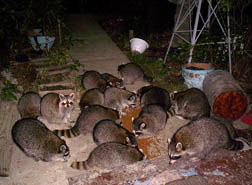 The abnormally high number of raccoons will cause disease and parasite outbreaks that will kill them all slowly and painfully – as it will the other species of wildlife that once lived in that area. Avoiding this by keeping them locked up in cages for there natural lives is a very very cruel thing to do to a wild animal that was born to live free. I wish I could tell you something else, something you would rather hear, but I can’t.
The abnormally high number of raccoons will cause disease and parasite outbreaks that will kill them all slowly and painfully – as it will the other species of wildlife that once lived in that area. Avoiding this by keeping them locked up in cages for there natural lives is a very very cruel thing to do to a wild animal that was born to live free. I wish I could tell you something else, something you would rather hear, but I can’t.
Aaron Writes:
I was reading this web page and noticed that you mentioned how unusually resistant Baylisascaris procyonis eggs are to heat. A while ago I ran across an article in which researchers determined that the ‘100% thermal death point’ of baylisascaris procyonis eggs was just 62 degrees C (144 F) sustained for some unspecified time but less than one minute. (read here) I always thought that typical sterilization temperatures were generally well in excess of 100 C. If this research is correct, then submerging a potentially infected object such as feeding bowl or toy in boiling water for one minute or running it through the ‘heated dry cycle’ on most consumer dishwashers (usually thermostatically maintained at 75 or 83 C) would be sufficient to kill any eggs on the object. With regard to potentially infected bedding materials, I suspect that an ordinary clothes dryer could achieve sustained internal drum temperatures of 62 C or more once most of the water had evaporated from whatever was being dried.



